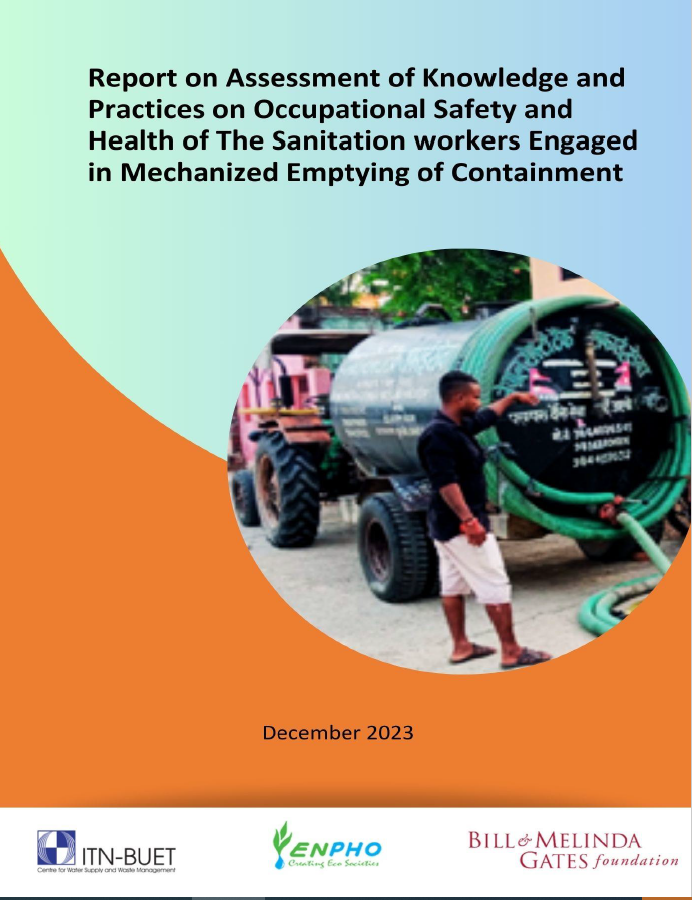Report of Knowledge and Practices on Occupational Safety and Health of Sanitation Workers engaged in Mechanized Emptying of Containment
Publisher(s): Environment and Public Health Organization (ENPHO)

Category(s): Reports
Series Name: Research Report_Knowledge and Practice on OSH
Language: English
Publication Year: 2023
Document Type: pdf
The government of Nepal has envisioned access to safe drinking water and sanitation for every citizen through its constitution. It has promogulated national sustainable development goals to access adequate and equitable sanitation and hygiene for all and end open defecation in target 6.2. The SDG emphasizes safely managed sanitation services rather than access to basic sanitation facilities. Achieving safely managed sanitation through the conventional approach in urban areas by developing a sewer network and treatment is not enough as well as affordable to everyone. Thus, City Wide Inclusive Sanitation approach with three fundamental outcomes such as equity, safety and sustainability had been put forward for achieving the target. The approach emphasizes capacity building for non-infrastructure aspects of service delivery, that has been overlooked. Particularly, the occupational safety and health of sanitation workers engaged in sanitation service providers are neglected despite the legal provision of occupational safety and health.
The occupational safety and health of the sanitation workers can be maintained only when they are educated, required safety equipment is provided and practice the safety and hygienic behaviour. Thus, this study aimed on assessing the knowledge of occupational safety and health of the sanitation workers, availability of basic personal protective equipment and health and hygiene behaviour of those engaged in mechanized desludging services.
The study was conducted in the Kathmandu Valley and Janakpurdham Sub-metropolitan City. The criteria for selecting these cities are:
i. In both cities, the demand for desludging is high. It is reported that at least 30 and 20 desludging vehicles are providing services in these cities.
ii. As per 2019, Human Development Index of the Bagmati Province is the highest with 0.669 and the lowest in the Madhesh Province with 0.519 in the country. Thus, assessment of knowledge and practices from both upper and lower region based on HDI provides in-depth understanding.
The in-depth questionnaire survey with 42 and 36 sanitation workers from the Kathmandu valley and Janakpurdham was conducted. Similarly, the direct observation of emptying process was observed in 10 and 18 working sites in the valley and Janakpurdham.
The major findings of the study were that the sanitation workers engaged in the emptying, transportation, and disposal of faecal sludge are prone to physical, chemical, and biological hazards. Lifting heavy cover slab and mishandling of the equipment has higher potential to injure them. The risk of contamination from FS has higher potential to degrade the health and wellbeing. Most of the sanitation workers are from socially marginalized and discriminated families with lower educational attainment, following the traditional profession. Also, majority of them have chosen the profession following their friends and relatives, seeking higher income. Self-awareness on importance of safety in the work and enhancing skill and capacity was high among them but were not trained accordingly. The risk of getting injured with the use of locally assembled desludging vehicles containing heavy suction pumps that needed to be lifted every time was increased, particularly in Kathmandu Valley. They were working based upon the knowledge gained by doing. Thus, it was observed knowledge on labour intensive activities such as necessary tools and precautions to be followed for clearance of site, removing the cover slab of the containment, and holding the suction hose was high. Despite having the knowledge, its implementation remained limited either due to inadequate tools or insufficient awareness about the potential risks to their safety and health from mishandling of the tools.
Significant knowledge gap was observed in maintaining health and hygiene behaviour by the sanitation workers. The lack of adequate PPE despite having the knowledge of its importance, unwilling to adopt proper handwashing with soap and water and unawareness on first aid and responses toward preventing infections from minor injuries had escalated the risk of degrading health and wellbeing even with minor accidents in the workplace.
The major recommendations for occupational safety and health of the sanitation workers engaged in emptying profession of the containment are:
i. Equipped sanitation workers with technically better equipment for emptying process. The mechanism to verify the quality of the equipment must be developed.
ii. Ensure the availability of an adequate and quality set of personal protective equipment for all the sanitation workers.
iii. The sanitation workers should be trained on critical handwashing conditions focusing on the critical incidents in the emptying process that have potential risk to biological hazard.
iv. The sanitation workers should be trained on first aid and preventive measures of infection from minor injuries. Also, the availability of a first aid kit should be mandatory in the desludging vehicles.
v. Provision of periodic health check-ups of sanitation workers should be assured.
Topic
Behavior Change, Public Health
Focus Area
Hygiene
Keywords
OSH, sanitation workers,
Country
Nepal
Copyright
This is an open access work distributed under the terms of the Creative Commons Attribution License, which permits unrestricted use, distribution, and reproduction in any medium, provided the original work is properly cited.
No comment yet.